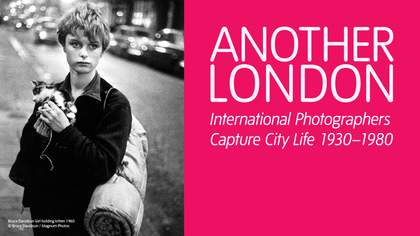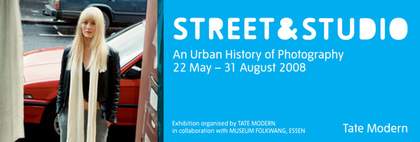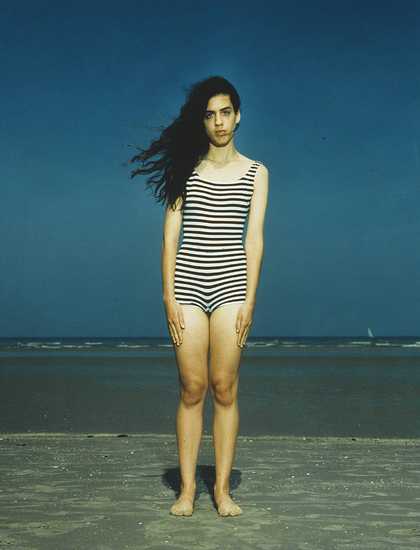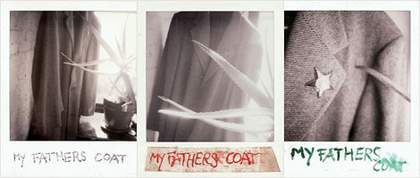In 1959 Erving Goffman published his sociological masterpiece, The Presentation of Self in Everyday Life, in which he famously likened everyday human interaction to a performance, like theatre actors on a stage. Such performances, he claimed, are constructed to provide others with impressions, mostly shaped by the observer – a process he called ‘the arts of impression management’. For Goffman, the observer, not the player, mattered most.
In recent years, four women artists – Vanessa Beecroft, Nikki S. Lee, Catherine Opie and Collier Schorr – have all documented well-defined social groups that tend to be gender-specific, often primarily male, recording their observations mostly through still photography. Schorr’s series The Wrestlers 2004 and Wrestlers Love America 2004, for example, result from the years Schorr (born New York City, 1963) has spent photographing the suburban practitioners of this sport. Catherine Opie (born Sandusky, Ohio, 1961) has documented various, often alternative, communities, including her West Coast lesbian milieu (Portraits 1994), lesbian and gay families across America (Domestic 2000) and her latest series, Surfers 2004.
Vanessa Beecroft (born Genoa, Italy, 1969) is known for her highly stylised group performances of minimally clad, statuesque young women, often provocatively exposed. Finally, Nikki S. Lee (born Kye-Chang, South Korea, 1970) photographed herself as a participating member of different subcultures – punks, tourists, schoolgirls, the elderly, skateboarders and exotic dancers – over a period from 1997 to 2001. From the start, Lee would reveal (with some discretion) to her host subculture that she was an artist, and then embark on a one-month assimilation project in which she entered into the identity of the group, taking on aspects of their lives, including hairstyles and eating patterns. Curiously, Erving Goffman once enacted a similar masquerade. He pretended to be an American interested in agricultural techniques on a visit to a small Scottish island, when, in fact, he was there to collect ethnographic data, inconspicuously absorbing as much as he could about the inhabitants’ everyday lives.
An artist-photographer, like an ethnographer, detective or invigilator, is one of many professionals whose work centres on the act of looking. Just as there are varying styles of sociological observation, there are various positions the artist-photographer can assume in, or before the group: comrade; groupie; photojournalist; lover. A convenient comparison was offered earlier this year when Schorr’s The Wrestlers and Opie’s Surfers were on view simultaneously in two London galleries. Two American women photographers, both openly gay, both about the same age, both looking into predominantly young, male communities built around notoriously inward-looking sports. But there the similarities end. The photographs are very different.
Schorr’s pictures are sculptural, emotionally charged portraits of youth. Although not exactly sex symbols, these boys are presented as beings we are meant to feel for, even desire. Their skin looks unusually vulnerable, sometimes bruised and bleeding; their expressions reflect a blank, youthful dedication to the sport. The artist says she wanted to document every facet of the experience: victory, defeat, blood, battered egos, humiliation. ‘This is the project where I just go and throw myself in. I’m literally dancing in between 30 pairs of guys,’ she says.
Opie’s Surfers are more embedded within the art historical genres of portraiture and landscape. By adopting the head-and-torso composition of northern Renaissance portraits and using a flat, grey, shadowless light, the artist has positioned herself squarely before her subjects, maintaining a traditional distance. These individual portraits are coupled with landscapes featuring many figures, very small, dotted in an immense and unwelcoming ocean, and here the distance grows even greater: sometimes Opie seems at risk of losing her surfers altogether to the vast sea.
In contrast, Schorr’s figures are very close in all their glossy, chiaroscuro drama: dark tank tops against pale skin, beating hearts and spilled blood. She succeeds in entering a kind of fraternal intimacy, getting right under their shirts, almost exchanging fluids like a blood brother. Over the years, so constant is her presence that she effectively becomes invisible, like a shadow ‘dancing’ weightlessly among the boys. Schorr is the observer as confidante; Opie the discrete, if empathetic, guest.
Perhaps the most emblematic example of an overtly sociological role assumed by a recent artist is that by Nikki S Lee. In a sense her work is pure sociology. She even delegates the actual photography to others. The pictures show Lee participating in some defining group activity – tongue-wagging debauchery on the couch with a group of transvestites (The Drag Queen Project 1997); romance on the roof among the lesbians (The Lesbian Project 1997); and a well-mannered lunch break in an urban park with her fellow besuited colleagues (The Yuppie Project 1998). The fact that the artist is a Korean living in New York can’t be ignored, and most critics have not done so. Many foreigners arriving in the US from a rather homogeneous culture, and having decided to become an American, must face a real dilemma: ‘What kind of American should I become?’ Lee responds with a sampler of the available socioeconomic and racial options.
In the late 1980s Japanese artist Yasumasa Morimura began computer-manipulating reproductions of Western art masterpieces, surreptitiously inserting his likeness into Manet’s Olympia or Velázquez’s Infanta Margarita. At a time when the Japanese were buying van Gogh’s Sunflowers and the image rights to the Sistine Chapel, Morimura’s pictures were a commentary on Western fear of the then emerging Far Eastern economic might. The unspoken anxiety was that Western culture was not only being admired and supported, but co-opted, corrupted and possessed. Lee stages a similar enactment. It is as if the artist, the ‘suspicious’ immigrant, is easing her way into the deepest, most impenetrable corners of American life, confirming the worst American fears of outside infiltration – and then flaunting the images of her multiple, successful invasions.
When we look at Lee’s group portraits we take the sincerity of everybody else’s performance as the given, against which to judge the accuracy of the artist’s. Our observation consists mostly of looking for cracks in the façade of Lee’s performance (usually there are none). In this sense she manages to erase her companions altogether: she is the only ‘real’ person depicted, the object of our attention. Everybody else becomes a prop, part of what Goffman defined as ‘The Front’: the total setting against which the social performance is enacted. While Schorr becomes an invisible observer through her constant, shadow-like presence, Lee does the reverse: it is her subjects themselves who are made to vanish.
Lee does, however, personally expose herself considerably, both at the hands of the group and the art world. Is she, like Woody Allen’s pathetic Zelig, desperate to fit in? The pictures suggest an unhappy foreign exchange student, faking scenarios of new-found popularity to reassure the folks back home: ‘Dear Mom and Dad, I LOVE the US! I’ve made lots of fantastic friends and school is really great!’ She has been likened to a cultural tourist, or an anthropologist doing fieldwork, or an explorer, such as Marco Polo returning from China and recounting the marvels he witnessed on his uncharted travels.
Vanessa Beecroft’s interaction is different. Part director, part sculptress, she stages rigorous performances. Her VB39 and VB42 Intrepid: The Silent Service (both 2000) featured the American Navy SEALs, the most highly trained section of the US military. VB39 was held at the Museum of Contemporary Art in San Diego, where the SEALs occupied the main gallery, standing at attention for some two hours. For the second performance, VB42, the art audience was escorted at night on to the SS Intrepid, an aircraft carrier floating in New York’s harbour. Beecroft arranged the SEALs (30 sailors from the Undersea Warfare Community) on the flight deck, while the visitors milled around them. Uniformly dressed in blue and set in neat, even rows, they were like chess pieces of a single colour.
While in the first instance Beecroft was essentially just updating Duchamp’s operation from 83 years earlier by introducing the most inappropriate thing the artist can think of (in his case a urinal) into an art space, in VB42 she effectively took Duchamp one step further. Forcing an art crowd out of its cosy gallery environment on to a functioning navy ship is as if Duchamp had dragged the fusty art crowd of 1917 into the men’s toilets, to stand around and watch them in action – something that he never managed, or dared, to do.
VB42 has a perfect one-point perspective, and looking at the photographs of the event we occupy the central vantage point, like a conductor facing a marching band. Beecroft turns us, not the artist, into the defining observers. She, like Schorr, makes herself an invisible observer, but she is Big Brother rather than fluid, omnipresent ghost: the all-seeing, and never seen, observer. Although the SEALs period in Beecroft’s career is in some ways her least successful, it is her most revealing. Art historian Norman Bryson has likened her role here as that of a supreme commander. Certainly she was at ease with the navy (at one point she even considered joining) and managed to impose her will upon its men.
The picture of the United States as a tolerant shelter, welcoming a multiplicity of cultures, sexualities, lifestyles and religions, is at odds with an increasingly negative political view of the nation as an isolated, intolerant, cultural monolith. In this sense Nikki S Lee probably does the country a favour, portraying it as a diverse and accommodating collection of peacefully coexisting microcosms. And Catherine Opie has shown another version of the American dream: East, Middle and West 2000 depicted many distinctly American architectural phenomena: the LA freeway, shopping malls, Midwestern ice houses. Opie’s first London exhibition was aptly called Altered States of America, a sign of how she was keen to reveal to Americans their own diversity. ‘America is not straight, even though America would like to think of itself as straight,’ she has said.
Beecroft, meanwhile, projects a sense of Americanness in her work. She said that her SEALs project could have taken place only in the US; presumably no other military authority in the world would entertain the notion of an artist – a woman, no less – borrowing the country’s most prepared armed forces for an evening. She sees the men as ‘Hollywood characters’ and likens the performers’ discipline to Jackson Pollock or Donald Judd, two quintessentially American figures. And Collier Schorr’s subjects too are unmistakably American. Critic Helen Molesworth has pointed out their ‘casual ease and sense of entitlement that are markers of American boyhood’. Schorr herself has written on the allure of the young American alpha male, describing the US soldiers based in Germany as ‘dreamy guys… noticeable by their Cameros and Firebirds, their crew cuts and their dark skins’.
Notable in all this, perhaps surprisingly, is a sense of nostalgia for a certain romantic America. Schorr explains that she chose wrestling in part because it is a sport in decline; The Wrestlers reflects her desire to record it before it vanishes altogether. Opie also ascribes a preserving role to photography: ‘I am somehow able to contain within the Portraits series an incredible sense of history, of what was happening politically as well as socially at that time.’
In 1955, while Goffman was continuing his sociological studies by observing daily life in a Washington DC hospital, Swiss-born photographer Robert Frank went to the States to create a portrait of the nation which later became his seminal photography book, The Americans (see ‘Six Reflections on the Photography of Robert Frank’). It was not a flattering picture: racially divided, unevenly enjoying the spoils of the Second World War. His black-and-white photographs captured the ambiguity of the American experience. As Jack Kerouac put it: ‘Robert Frank, Swiss, unobtrusive, nice, with that little camera… sucked a sad poem right out of America on to film.’ Curiously, Nikki S. Lee has also explained the ease with which she enters Big America by virtue of her small, unthreatening person: ‘I’m really petite – people don’t think I’m going to punch them and kill them.’ The small observer, or better still the invisible observer, can perhaps move best on this immense stage. ‘All the world is not, of course, a stage,’ said Goffman, ‘but the crucial ways in which it isn’t are not easy to specify.’




